NavSource Online: Battleship Photo
Archive
BB-31 USS UTAH
1909 - 1913
http://www.navsource.org/archives/01/31a.htm |
To Additional
Pages
1914
- 1918
1919
- 1926
1927
- December 6, 1941
December
7, 1941-Present
Florida Class Battleship: Displacement
21,825 Tons, Dimensions, 521' 6" (oa) x 88' 3" x 30'
1" (Max). Armament 10 x 12"/45 16 x 5"/51, 2 x
21" tt. Armor, 11" Belt, 12" Turrets, 3"
Decks, 11 1/2" Conning Tower. Machinery, 28,000 SHP;
Direct Drive Turbines, 4 screws. Speed, 20.75 Knots, Crew
1001.
Operational and Building Data: Laid down by New
York Shipbuilding, Camden NJ., March 15, 1909. Launched
December 23, 1909. Commissioned August 31, 1911. Converted and
reclassified Target Ship AG-16, April 1, 1932.
Decommissioned (War Loss). Stricken November 13, 1944.
Fate: Sunk by Japanese aircraft during attack on
Pearl Harbor Hawaii, December 7, 1941. Her hulk still rests
rolled over in her berth, serving as a memorial to this day. 6
Officers and 58 Men were lost with the ship and remain on
duty.
 In Memorium:
In Memorium:
In the Second Book of Shmuel (Samuel), 22nd chapter, 5th
through the 19th verses, translated from the original in
Hebrew and published by the Koren
Publishers of Jerusalem, Israel, can perhaps aptly
describe the fate of the crew and all other U.S.sailors who
died defending their county:
"When the waves of death compassed me / the floods of
ungodly men made me afraid; / the bonds of She'ol encircled
me; / the snares of death took me by surprise; / in my
distress I called upon the Lord, / and cried to my G-D: / and
he heard my voice out of his temple, / and my cry entered into
his ears. / Then the earth shook and trembled; /the
foundations of heaven moved / and shook because of his anger
/...the heavy mass of waters, and thick clouds of the skies
/... And the channels of the sea appeared, / the foundations
of the world were laid bare, / at the rebuking of the Lord, at
the blast at the breath of his nostrils. / He sent from above,
he took me; / he drew me out of many waters; / he delivered me
from my strong enemy, and from those who hated me; for they
were too strong for me. / They surprised me in the day of my
calamity: / but the Lord was my stay..."
Penelope's Song courtesy of Loreena McKennitt via quinlanroad.com.
Click On Image
For Full Size Image |
Size |
Image Description |
Contributed
By And/Or Copyright |
 |
2.80k |
The battleship Utah (BB-31)
as she will look when completed.
| Image and text provided by University of Utah,
Marriott Library.
Photo from The Salt Lake Herald-Republican.
(Salt Lake City, Utah) 1909-1918, 15 November 1908,
via chroniclingamerica.loc.gov. |
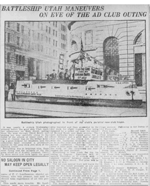 |
733k |
BATTLESHIP UTAH (BB-31)
MANEUVERS.... |
Image and text provided by University of Utah,
Marriott Library.
Photo from The Salt Lake Herald-Republican.
(Salt Lake City, Utah) 1909-1918, 01 July 1909, Image
2, via chroniclingamerica.loc.gov.
|
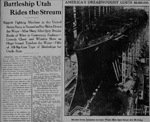 |
2.13k |
AMERICA'S DREADNOUGHT COSTS
$8,000,000.
Battleship Utah (BB-31) Rides the Stream
Biggest Fighting Machine in the United States Navy
is Named as She Slides Down the Ways
Miss Mary Alice Spry Breaks Bottle of Wine in
Customary Fashion
Crowds Cheer and Whistles Blow as Huge Vessel Touches
the Water
Fifth of All Big Gun Type of Battleships for Uncle Sam
| Image and text provided by University of Utah,
Marriott Library.
Photo from Deseret Evening News. (Salt Lake
City, Utah) 1909-1918, 24 December 1909, Image 1
(Great Salt Lake City [Utah]) 1867-1920, 23 December
1909, Last Edition, Image 1, via
chroniclingamerica.loc.gov. |
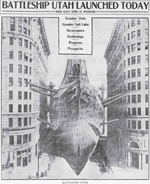 |
665k |
BATTLESHIP UTAH (BB-31)
LAUNCHED TODAY
| Image and text provided by University of Utah,
Marriott Library.
Photo from The Salt Lake Tribune. (Salt Lake
City, Utah) 1909-1918, 24 December 1909, Image 1
(Great Salt Lake City [Utah]) 1867-1920, 23 December
1909, Last Edition, Image 1, via
chroniclingamerica.loc.gov. |
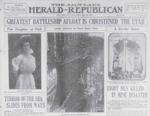 |
1.64k |
Terror of the seas slides from the
ways.
I christen thee Utah (BB-31).
In a clear and musical voice spoke out Miss Mary Alioe
Spry as the worlds greatest death dealing monster slid
from its ways and grace fully glided into its watery
home. I christen thee Utah echoed the
vast concourse of assembled guests and as the
reverberations died away the workmen who for months
had toiled to build the mighty vessel bowed their
heads in awed silence and suddenly as would a
victorious army their husky voices shouted back I
christen thee Utah.
Scene at launching recently of the battleship North
Dakota (BB-29), a terror of the deep built
much along the lines of the Utah.
| Image and text provided by University of Utah,
Marriott Library.
Photo from The Salt Lake Herald-Republican.
(Salt Lake City, Utah) 1909-1918, 24 December 1909,
Images 1 & 6, via chroniclingamerica.loc.gov. |
 |
2.29k |
Scenes at launching of battleship Utah
(BB-31).
| Image and text provided by University of Utah,
Marriott Library
Photo from The Desert Evening News, 27 December
1909, via chroniclingamerica.loc.gov. |
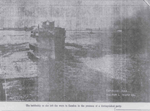 |
1.80k |
The battleship as she left the ways in
Camden in the presence of a distinguished party.
| Image and text provided by University of Utah,
Marriott Library.
Photo from The Salt Lake Herald-Republican.
(Salt Lake City, Utah) 1909-1918, 28 December 1909,
Image 2, via chroniclingamerica.loc.gov. |
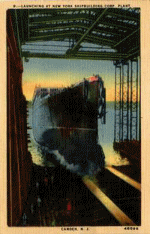 |
52k |
Utah (BB-31) launching at
New York Shipbuilding Corp. Plant. The ship is not
identifiable, but, the bow curve suggests an early
American dreadnought such as Utah,
launched in 1909. |
Photo & text courtesy of New York Shipbuilding.,
yorkship.home.comcast.net. |
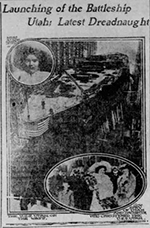 |
4.27k |
WORLD'S BIGGEST BATTLESHIP;
HOW THE UTAH (BB-31) LOOKS TODAY
| Image and text provided by Washington State Library;
Olympia, WA.
Photo from The Tacoma Times. (Tacoma, Wash.)
1903-1949, 29 December 1909, Image 2, via
chroniclingamerica.loc.gov.
|
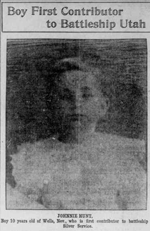 |
1.92k |
Boy First Contributor to Battleship Utah
(BB-31)
JOHNNIE HUNT
Boy 10 years old of Wells Nev who is first contributor
to battleship Silver Service.
| Image and text provided by University of Utah,
Marriott Library.
Photo from The Salt Lake Herald-Republican.
(Salt Lake City, Utah) 1909-1918, 24 April 1910,
Section One, Image 12, via chroniclingamerica.loc.gov. |
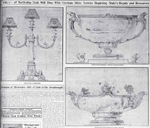 |
635k |
Officers of Battleship Utah (BB-31)
Will Dine With Glorious Silver Service Depicting
State's Beauty and Resources
| Image and text provided by University of Utah,
Marriott Library.
Photo from The Salt Lake Tribune. (Salt Lake
City, Utah) 1890-current, 18 June 1910, Image 3, via
chroniclingamerica.loc.gov. |
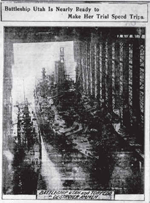 |
533k |
The battleship Utah (BB-31)
is nearly ready to make her trial speed trips.
| Photo from The Logan Republican, (Logan,
Utah) 1902-1924, 21 January 1911.
Image and text provided by University of Utah,
Marriott Library via chroniclingamerica.loc.gov. |
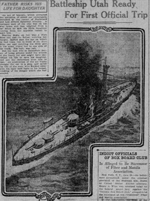 |
750k |
Birdseye view of the battleship Utah
(BB-31), the largest warship so far completed
for the United States Navy, which has left the yard of
the New York Shipbuilding company at Camden, N. J.,
for her official trial off the New England coast. The
new ship must develop a speed of 20.5 knots an hour to
comply with the government's requirements. The speed
test will take place probably today over the measured
course off Rockland, Maine. The Utah has
a displacement of 21,875 tons, while the battleship Delaware
(BB-28), the biggest Dreadnought in the
fleet now assembled off Portsmouth, England, for the
coronation review of King George, has a displacement
of 20,000 tons.
| Image and text provided by University of North
Texas; Denton, TX.
Photo from El Paso Herald. (El Paso, Tex.)
1901-1931, 26 June 1911, Image 1, via
chroniclingamerica.loc.gov. |
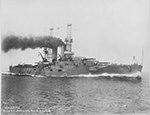 |
642k |
The Utah (BB-31) during
her trials, 16th run at 21 knots. |
Photographed by N.L. Stebbins, Boston,
Massachusetts.
US National Archives photo # 80G-103105 from NARA,
College Park, Maryland, courtesy of Sean Hert,
Webmaster & Editor ModelWarships.com
|
 |
541k |
Uncle Sam's Latest Dreadnought In
Action
The new battleship Utah (BB-31), latest
of the U.S. dreadnoughts, was commissioned here today,
having completed her tests successfully.
| Image and text provided by University of Hawaii at
Manoa; Honolulu, HI.
Photo from Evening Bulletin. (Honolulu [Oahu,
Hawaii) 1895-1912, 31 August 1911, 3:30 EDITION, Image
1, via chroniclingamerica.loc.gov. |
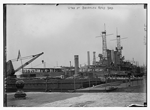 |
561k |
Utah (BB-31) at Brooklyn
Navy Yard.
Photo dated circa 12 September 1911 |
Photo courtesy of the Boston Public Library, Leslie
Jones Collection via flickr.com. |
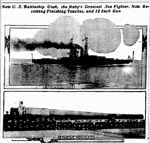 |
2.13k |
New U. S. Battleship Utah (BB-31),
the Navy's Greatest Sea Fighter, Now Receiving
Finishing Touches, and 12 Inch Gun
| Image and text provided by State Historical Society
of North Dakota.
Photo by Bismarck Daily Tribune. (Bismarck,
Dakota [N.D.]) 1881-1916, 14 September 1911, Image 1,
courtesy of chroniclingamerica.loc.gov.
PDF added 03/22/13. |
 |
683k |
$28,000,000 TO PUT BIGGEST
DREADNAUGHT UTAH (BB-31) INTO ACTION.
$250,000 an Hour Is the Expense of Fighting Newest
Warship
While Her Maintenance Costs $832,000 a Year, or More.
| Image and text provided by The New York Public
Library, Astor, Lenox and Tilden Foundation.
Photo from The Evening World. (New York, N.Y.)
1887-1931, 16 September 1911, Final Edition, Image 12,
via chroniclingamerica.loc.gov. |
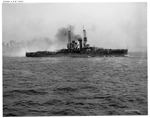 |
224k |
Starboard broadside of the Utah (BB-31)
underway at an unknown location with the crew lining
the rails between 1911 and 1915. |
Photo from Library of Congress; # Library of
Congress, LC-D4-22783 via Mike Green. |
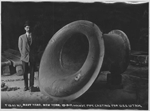 |
224k |
Hawse pipe casting for Utah (BB-31),
October 1911. |
Photo No. f1041n1, Brooklyn Navy Yard Archive -
courtesy National Archive and Records Administration,
Northeast Region - NYC, Record Group 181 via
flickr.com. |
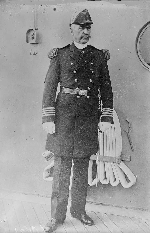 |
70k |
In 1911, Captain William S. Benson
became the first Commanding Officer of the battleship Utah
(BB-31). |
Digital ID: # ggbain 25778. Source: Library of
Congress Prints and Photographs Division Washington,
D.C. & submitted by Bill Gonyo. |
 |
56k |
Underway, possibly during her trials in
1911. |
USNHC # NH 63201. |
 |
132k |
The ship as completed in late 1911. |
USN photo. |
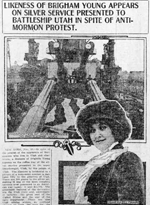 |
703k |
LIKENESS OF BRIGHAM
YOUNG APPEARS ON SILVER SERVICE PRESENTED TO
BATTLESHIP UTAH (BB-31) IN SPITE OF ANTI MORMON
PROTEST.
| Image and text provided by University of North
Texas; Denton, TX. & University of Utah, Marriott
Library.
Photo from El Paso Herald (El Paso, Tex.)
1901-1931, 14 December 1910, Image 16 & The
Evening Standard. (Ogden City, Utah) 1910-1913, 11
November 1911, Image 8, via chroniclingamerica.loc.gov. |
 |
875k |
SNUB BY CAPTAIN OF WARSHIP UTAH (BB-31)
IS CHARGE OF D.A.R.
Women Warned Against Assailing Mormons, in Presenting,
Silver, IT IS Said.
| Image and text provided by Library of Congress,
Washington, DC.
Photo from The Washington Times. (Washington
[D.C.]) 1902-1939, 12 November 1911, Sunday Evening
Edition, Image 1, via chroniclingamerica.loc.gov. |
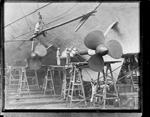 |
316k |
Utah (BB-31) showing
propellers.
Photo dated 27 November 1911. |
Photo courtesy of the Boston Public Library, Leslie
Jones Collection via flickr.com. |
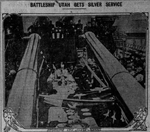 |
1.20k |
BATTLESHIP UTAH (BB-31) GETS
SILVER SERVICE
THE silver service purchased by 30,000 school children
of Utah for the new battleship Utah was
presented by Governor Spry to Capt William S. Benson,
commander of the vessel, in the New York navy yard the
other day. The gift, displayed on a long table between
two immense guns, was unveiled by Miss Hazel Tout.
| Image and text provided by Louisiana State
University; Baton Rouge, LA.
Photo from Tensas Gazette. (St. Joseph, La.)
1886-current, 22 December 1911, Image 12, via
chroniclingamerica.loc.gov. |
 |
177k |
Utah (BB-31) in Guantanamo
Bay. This photo possibly dates during her shakedown
cruise;-a voyage that took her to Hampton Roads, Va.;
Santa Rosa Island and Pensacola, Fla.; Galveston,
Tex.; Kingston and Portland Bight, Jamaica; and
Guantanamo Bay, Cuba. Utah was assigned
to the Atlantic Fleet in March 1912. |
USN photo # 80-G-1025113 courtesy of
interwarnavy.org via Bill Gonyo. Text courtesy of
DANFS. |
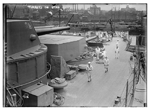 |
406k |
Forward turrets of the Utah (BB-31),
possibly at Philadelphia, PA. |
Digital ID: # 2163693498_47d91aa26d_o. Source:
Library of Congress Prints and Photographs Division,
from the George Grantham Bain Collection, courtesy of
Tom Kermen. |
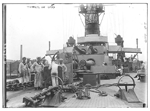 |
187k |
Forward turrets of the Utah (BB-31).
Note the metal grating on deck over the anchor chains. |
Digital ID: Call # LC-B2-2267-11. Source: Library of
Congress Prints and Photographs Division, from the
George Grantham Bain Collection, courtesy of Tom
Kermen. |
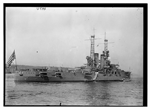 |
280k |
Stern view of the Utah (BB-31)
at the New York Naval Review. Note her rear secondary
gun ports are open. |
Digital ID: # 2422670411_e9d19cf7b3_o., LOC #
LC-B2-2455-2. Source: Library of Congress Prints and
Photographs Division, from the George Grantham Bain
Collection, courtesy of Tom Kermen. |
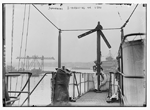 |
114k |
Semaphore signaling on Utah (BB-31). |
Digital ID: ggbain.09584 # 2162892615_7a7f48e09c_o.
Call # LC-B2- 2267-15. Source: Library of Congress
Prints and Photographs Division, from the George
Grantham Bain Collection, courtesy of Tom Kermen. |
 |
1.00k |
Officers and crew of the Utah (BB-31)
on 10 May 1912.
The day before, the Utah succeeded in
becoming the first ship to use the new Drydock
at the Brooklyn Navy Yard which had a reputation as a
man killer. |
Photo courtesy of the Library of Congress Prints
& Photos Division, LC-USZ62-137330, Photo #
6a33021 by H.H. Howard. Photo courtesy of Tom Kermen.
PDF image and text provided by The New York Public
Library, Astor, Lenox and Tilden Foundation.
Photo from The Evening World. (New York, N.Y.)
1887-1931, 09 May 1912, Final Edition, Image 1, via
chroniclingamerica.loc.gov. |
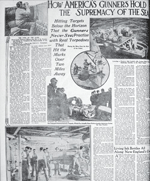 |
650k |
HOW AMERICA'S GUNNERS HOLD THE
SUPREMACY OF THE SEA
THE EYES OF THE GUNS
Above is the Ordinance Officer who sits in the Foretop
and Directs by Telephone the Marksmanship of the
Gunners Below.
At the Bottom of the page is the Crew of a Seven inch
Gun on the Utah (BB-31)
Lowering a Pontoon Raft with Contact Mines from
Battleship South Carolina (BB-26) to the
Ship's Cutter
Placing the Mines from the Bow to the Cutter |
Photos by enrique Mueller
Image and text provided by University of Utah,
Marriott Library.
The Salt Lake Tribune. (Salt Lake City, Utah)
1890-current, 12 May 1912, Magazine Section, Image 38,
courtesy of chroniclingamerica.loc.gov. |
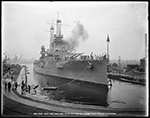 |
715k |
UNCLE SAM'S BIGGEST DRYDOCK TAKES IN UTAH
(BB-31), BIGGEST BATTLESHIP, WHICH WILL HAVE DENTS IN
ARMOR STRAIGHTENED OUT
The Utah is in the navy hospital because
of a British tramp steamship trying to got to sea in a
fog dented a few of her bow plates as she lay off
Tompklnsvllle, Staten Island, on the same day that the
Titanic foundered.
| Image and text provided by University of Utah,
Marriott Library.
Photo from The Evening Standard. (Ogden City,
Utah) 1910-1913, 15 May 1912, Image 1, via
chroniclingamerica.loc.gov. |
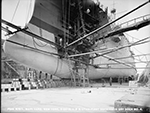 |
1.00k |
First dry docking of the Utah (BB-31),
Dry Dock # 4, 22 May 1912. |
Photo No. f544n751, Brooklyn Navy Yard Archive -
courtesy National Archive and Records Administration,
Northeast Region - NYC, Record Group 181 via
flickr.com. |
 |
538k |
YANKEE NAVY AT TARGET
PRACTICE
The Michigan (BB-27) firing broadside.
2. Same, nearer view. 3. Going to look at target. 4.
Big gun at moment of firing. 5. Battleships in line.
6. Ready to lay mines. 7. Setting up target. 8.Utah
(BB-31) firing broadsides. 9. Target in
position. |
Photos by Enrique Muller.
Image and text provided by University of Hawaii at
Manoa; Honolulu, HI.
Photo from The Hawaiian Star (Honolulu [Oahu])
1893-1912, 31 May 1912, SECOND EDITION, SECOND
SECTION, Image 9, via chroniclingamerica.loc.gov. |
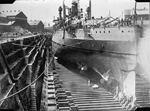 |
717k |
Stern view of the Utah (BB-31)
in an unknown drydock sometime between 1909 and 1914. |
Library of Congress photo # LC-H261-1188 via Mike
Green. |
 |
319k |
Delaware (BB-28) with what
probably are Utah (BB-31) & Arkansas
(BB-33) in 1913. |
Photo i.d. courtesy of Chuck Haberlein & Ronald
J. Nash.
Library of Congress Reference number # LC-H261-3207,
courtesy of Tracy White. |
 |
64k |
The Utah (BB-31) Number
One Turret's crew posing under their turret's
12"/45 guns in 1913. Chief Turret Captain Abraham
DeSomer seated at right in the center of the front
row. To his right is the Turret Officer, Ensign Arthur
S. Carpender. DeSomer received the Medal of Honor for
his "extraordinary heroism" during the
seizure of Vera Cruz, Mexico, 21-22 April 1914. |
USNHC photo # NH 103835, from the collection of
Lieutenant Commander Abraham DeSomer, USN. Donated by
Lieutenant Colonel Russell DeSomer, U.S. Air Force
(Retired), 1975. |
 |
59k |
Taking green water over the bow in the
Atlantic, while returning from the Mediterranean Sea
in December 1913. A severe storm had just passed and
seas were still heavy. Photographed by E. Muller, Jr. |
USNHC # NH 63650. |
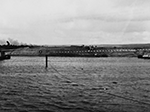 |
74k |
The Utah (BB-31) prior to
1914. |
USNHC # NH 90359. |
Utah (BB-31) History
View This Vessels DANFS
History Entry
(Located On The Hazegray & Underway Web Site, This Is The
Main Archive For The DANFS Online Project.)
Crew Contact And Reunion Information
Contact Utah (BB-31) Association Web Site Webmaster
Note About Contacts.
The contact listed, was the contact at the
time for this ship when located. If another person now is the
contact, E-mail me and I will update this entry. These
contacts are compiled from various sources over a long period
of time and may or may not be correct. Every effort has been
made to list the newest contact if more than one contact was
found.
Additional Resources
Hazegray
& Underway Battleship Pages By Andrew Toppan.
Utah
(BB-31) Report of Pearl Harbor Attack.
|
Utah (BB-31) History
View This Vessels DANFS
History Entry
http://www.hazegray.org/danfs/battlesh/bb31.htm |
From: DICTIONARY OF AMERICAN NAVAL FIGHTING SHIPS, Vol. VII,
pp. 421-424.
Utah
displacement. 21,825 (n.)
length. 521'6"
beam. 88'3"
draft. 28'4" (mean)
speed. 20.75 k.
complement. 1,041
armament. 10 12", 16 5", 2 21" tt.
class. Florida
Utah (Battleship No. 31) was laid down on 9 March
1909 at Camden, N.J., by the New York Shipbuilding Co.;
launched on 23 December 1909; sponsored by Miss Mary Alice
Spry, daughter of Governor William Spry of Utah; and
commissioned at the P hiladelphia Navy Yard on 31 August 1911,
Capt. William S. Benson in command.
After her shakedown cruise-a voyage that took her to
Hampton Roads, Va.; Santa Rosa Island and Pensacola, Fla.;
Galveston, Tex.; Kingston and Portland Bight, Jamaica; and
Guantanamo Bay, Cuba-Utah was assigned to the Atlantic
Fleet in March 1912. S he operated with the Fleet early that
spring, conducting exercises in gunnery and torpedo defense,
before she entered the New York Navy Yard on 16 April for an
overhaul.
Departing New York on 1 June, Utah briefly visited
Hampton Roads and then steamed to Annapolis, Md. where she
arrived on the 6th. There, she embarked
421
Naval Academy midshipmen and got underway on the 10th for
the Virginia Capes and the open Atlantic. She conducted a
midshipmen training cruise off the New England seaboard well
into the summer before disembarking her contingent of
officers-to-be back at Annapolis on 24 and 25 August. Soon
thereafter, the battleship headed for the Southern Drill
Grounds to conduct gunnery exercises.
For a little over two years, the dreadnought maintained
that schedule of operations off the eastern seaboard, ranging
from the New England coast to Cuban waters. During that time,
she made one cruise to European waters, visiting Villefranche,
France, from 8 to 30 November 1918.
Utah began the year 1914 at the New York Navy Yard
and sailed south on 5 January. After stopping at Hampton
Roads, she reached Cuban waters later in the month for torpedo
and small arms exercises. However, due to tension in Mexico, Utah
sai led for Mexican waters in early February and reached Vera
Cruz on the 16th. She operated off that port until getting
underway for Tampico on 9 April with several hundred refugees
embarked. Soon thereafter, it was learned that a German
steamship, SS Yp iranga,
was bound for Vera Cruz with a shipment of arms and
munitions earmarked for the dictator Victoriano Huerta. Utah
received orders to search for the ship and put to sea and
reached Vera Cruz on the 16th. When it appeared that the
shipment might be landed, the Navy took steps to take the
customs house at Vera Cruz and stop the delivery. Accordingly,
plans were drawn up for a landing at Vera Cruz, to commence on
21 April 1914.
Utah consequently landed her
"battalion"-17 officers and 367 sailors under the
command of Lt. Guy W. S. Castle-as well as her Marine
detachment, which formed part of the improvised "First
Marine Brigade," made up of detachments of marines from
the other ships that had arrived to show American
determination. In the ensuing fighting, in which the men of Utah's
bluejacket battalion distinguished themselves, seven won
medals of honor. Those seven included Lt. Castle, the
battalion commander; com pany commanders Ens. Oscar C. Badger
and Ens. Paul F. Foster; section leaders, Chief Turret
Captains Niels Drustrup and Abraham Desomer; Chief Gunner
George Bradley; and Boatswain's Mate Henry N. Nickerson.
Utah remained at Vera Cruz for almost two months
before returning north to the New York Navy Yard in late June
for an overhaul. Over the next three years, the battleship
operated on a regular routine of battle practices and
exercises from off the e astern seaboard into the Caribbean,
as the United States readied its forces for the possible entry
of the United States into the worldwide war that broke out in
July 1914.
After the United States finally declared war on 6 April
1917, Utah operated in the waters of the Chesapeake Bay
as an engineering and gunnery training ship and continued that
duty until 30 August 1918, when she sailed for the British
Isles with Vic e Admiral Henry T. Mayo, Commander in Chief,
United States Atlantic Fleet, embarked.
Fears of possible attacks by German heavy units upon the
large convoys crossing the Atlantic with troops and munitions
for the western front prompted the dispatch, to European
waters, of a powerful force of American dreadnoughts to Irish
waters. Utah
-as art of that movement-reached Brerehaven, Bantry Bay,
Ireland, on 10 September. There, she became the flagship of
Rear Admiral Thomas S. Rodgers, Commander, Battleship Division
6. Until the signing of the armistice on 11 November 1918,
Utah, a long with the sisterships Oklahoma (Battleship No. 37)
and Nevada (Battleship No. 36), operated from Bantry Bay,
covering the Allied convoys approaching the British Isles,
ready to deal with any surface threat that the German Navy
could hurl at the valuable transports and supply ships.
After the cessation of hostilities, Utah visited
Portland, England, and later served as part of the honor
escort for the transport George Washington (Id. No. 3018), as
that ship bore President Woodrow Wilson into the harbor of
Brest, France, on 13 December 1918. The following day, Utah
turned homeward and reached New York on Christmas Day 1918.
Utah remained at anchor in the North River; off New York
City, until 30 January 1919. During that time, she half-masted
her colors at 1440 on 7 January due to the death of former
President Theodore Roosevelt and, on the 8th, fired salutes at
half-h our intervals throughout the day in memory of the great
American statesman.
Utah carried out a regular routine of battle practices
and maneuvers, ranging from the New England coast to the
Caribbean, into mid-1921. During that time, she was classified
as BB-31 on 17 July 1920, during the Navy-wide assignment of
hull numbers .
Ultimately departing Boston on 9 July 1921, Utah
proceeded via Lisbon Portugal, and reached Cherbourg, France,
soon thereafter. There, Utah became the flagship for the
United States naval forces in European waters. She
"showed the flag" at t he principal Atlantic coast
ports of Europe and in the Mediterranean until relieved by
Pittsburgh (CA-4) in October 1922.
Returning to the United States on 21 October 1922, Utah
then became the flagship of Battleship Division (BatDiv) 6,
United States Scouting Fleet and operated with the Scouting
Fleet over the next three and one-half years.
Late in 1924, Utah was chosen to carry the United States
diplomatic mission to the centennial celebration of the Battle
of Ayacucho (9 December 1824), the decisive action in the
Peruvian struggle for independence. Designated as flagship for
the spe cial squadron assigned to represent the United States
at the festivities, Utah departed New York City on 22 November
1924 with General of the Armies John J. Pershing, USA, and
former congressman, the Honorable F. C. Hicks, embarked, and
arrived at Callao on 9 December.
Utah disembarked General Pershing and the other members
of the mission on Christmas 1924, so that the general and his
mission could visit other South American cities inland on
their goodwill tour. Meanwhile, Utah, in the weeks that
followed, called at the Chilean ports of Punta Arenas and
Valparaiso before she rounded Cape Horn and met General
Pershing at Montevideo, Uruguay. Reembarking the general and
his party there, the battleship then visited in succession:
Rio de Janeiro Brazil; La Gua ira, Venezuela; and Havana,
Cuba, before ending her diplomatic voyage at New York City on
18 March 1926. Utah spent subsequent summers of 1925 and 1926
with the Midshipman Practice Squadron and, after disembarking
her midshipmen at the conclusion o f the 1925 cruise, entered
the Boston Navy Yard and was decommissioned on 31 October 1925
for modernization. During that period of alterations and
repairs, the ship's "cage" mainmast was replaced by
a lighter pole mast; she was fitted to burn oil instead of
coal as fuel; and her armament was modified to reflect the
increased concern over antiaircraft defense. Interestingly,
Utah and her sistership Florida (BB-30) never received the
more modern "tripod" masts fitted to other classes.
Utah was placed back in commission on 1 December 1925
and, after local operations with the Scouting Fleet, departed
Hampton Roads on 21 November 1928, bound for South America.
Reaching Montevideo on 18 December, she there embarked
President-elect a nd Mrs. Herbert C. Hoover; the Honorable
Henry T. Fletcher, Ambassador to Italy; and members of the
press. Utah transported the President-elect's party to Rio de
Janeiro, Brazil, between 21 and 23 December, and then
continued her homeward voyage wi th Mr. Hoover embarked. En
route, the President-elect inspected the battleship's crew
while at sea, before the ship reached Hampton Roads on 6
January 1929.
However, Utah's days as a battleship were numbered.
Under the terms of the 1922 Washington Naval Treaty, Utah was
selected for conversion to a mobile target, in place of the
former battleship North Dakota; and, on 1 July 1931, Utah 's
classification was changed to AG-16. Her conversion-carried
out at the Norfolk Navy Yard-included the installation of a
radio-control apparatus. After having been decommissioned for
the duration of the conversion, Utah was recommissioned at
Norfolk on 1 April 1992, Comdr. Randall Jacobs in command.
Utah departed Norfolk on 7 April to train her engineers
in using the new installations and for trials of her radio
gear by which the ship could be controlled at varying rates of
speed and changes of course maneuvers that a ship would
conduct in bat tle. Her electric motors, operated by signals
from the controlling ship, opened and closed throttle valves,
moved her steering gear, and regulated the supply of oil to
her boilers. In addition, a Sperry gyro pilot kept the ship on
course.
Returning to port on 21 April, Utah passed her radio
control trials off the Virginia capes on 6 May. On 1 June,
Utah ran three hours under radio control, with all engineering
stations manned; over the next two days, she made two
successful r uns, each of four hours duration, during which no
machinery was touched by human hands. Observers, however-two
in each fore room and two in each boiler room-kept telephone
information and recorded data.
Her trials completed, Utah departed Norfolk on 9 June.
After transiting the Panama Canal she reached San Pedro,
Calif., on 30 June, reporting for duty with Training Squadron
1, Base Force, United States Fleet. She conducted her first
target duty, f or cruisers of the Fleet, on 26 July, and
later, on 2 August, conducted rehearsal runs for Nevada
(BB-36), Utah being controlled from Hovey (DD-208) and Talbot
(DD-114).
Over the next nine years, the erstwhile battleship
performed a vital service to the fleet as a mobile target,
contributing realism to the training of naval aviators in
dive, torpedo, and high level bombing. Thus, she greatly aided
the development of tacti cs in those areas. On one occasion,
she even served as a troop transport, embarking 223 officers
and men of the Fleet Marine Force at Sand Island, Midway, for
amphibious operations at Hilo Bay, Hawaii, as part of Fleet
Problem XVI in the early summer of 1 936. She then transported
the marines from Hawaii to San Diego, Calif., disembarking
them there on 12 June 1936.
That same month, June 1935, saw the establishment of a
fleet machine gun school on board Utah while she continued her
mission as a mobile target. The former dreadnought received
her first instructors on board in August 1936, and the first
students drawn from the ships' companies of Raleigh (CL-7),
Concord (CL-10), Omaha (CL-4), Memphis (CL-13), Milwaukee
(CL-5), and Ranger (CV-4)-reported aboard for training on 20
September. Subsequently, during the 1936 an d 1937 gunnery
year, Utah was fitted with a new quadruple 1.1-inch machine
gun mount for experimental test and development by the machine
gun school. Some of the first tests of that type of weapon
were conducted on board.
Utah-besides serving as a realistic target for exercises
involving carrier-based planes-also towed targets during
battle practices conducted by the Fleet's battleships and took
part in the yearly "fleet problems." She transited
the Panama Canal on 9 January 1939 to participate in Fleet
Problem XX-part of the maneuvers observed personally by
President Franklin D. Roosevelt from the heavy cruiser Houston
(CA-30).
After providing mobile target services for the
submarines of Submarine Squadron 6 in the late autumn and
early winter of 1939, Utah devoted the eight months that
followed to special machine gun practices. The following
summer, Utah sailed fo r the Hawaiian Islands reaching Pearl
Harbor on 1 August 1940, and fired advanced antiaircraft
gunnery practice in the Hawaiian operating area until 14
December 1940, when she sailed for the west coast, returning
to Long Beach four days before Christmas.
For the next two months, Utah operated as a mobile
bombing target off San Clemente Island, Calif., for planes
from Patrol Wing 1, and from the carriers Lexington (CV-2),
Saratoga (CV-3), and Enterprise (CV-6). Utah retur ned to
Hawaiian waters on 1 April 1941, embarking gunners for the
Advanced Antiaircraft Gun School, men drawn from West Virginia
(BB-48), Oklahoma (BB-37) Colorado (BB-45), Phoenix (CL-46),
Nashville (CL-43),
Philadelphia (CL-41), and New Orleans (CA-32).
Over the weeks that followed, she trained her embarked
gunner students in control and loading drills for the 5-inch
batteries, firing runs on radio-controlled drone targets as
well as .50-caliber and 1.1-inch firing on drones and
balloons. Utah put into Los Angeles harbor on 20 May and there
embarked Fleet Marine Force passengers for transportation to
Bremerton, Wash. Putting the marines ashore a week later, the
ship entered the Puget Sound Navy Yard on 31 May 1941.
During the ensuing overhaul, Utah received repairs and
alterations designed to make her a more effective gunnery
training ship. The alterations included the addition of
5-inch/38-caliber guns in single mounts with gunshields-similar
to those fitted on the more modern types of destroyers then in
service. She also lost her prewar colors, being repainted in
overall measure one camouflage-dark gray with pale gray tops.
With war paint thus donned, Utah sailed for Hawaiian waters on
14 September, after visits to Port Townsend, Wash., and San
Francisco and San Pedro, Calif. She arrived at Pearl Harbor
soon thereafter and carried out antiaircraft training and
target duties through the late autumn.
Utah completed an advanced antiaircraft gunnery cruise
in Hawaiian waters shortly before she returned to Pearl Harbor
in early December 1941, mooring off Ford Island in berth F-11.
On the morning of 7 December 1941, the senior officer on
board-the captain and executive officer were ashore on
leave-was Lt. Comdr. Solomon S. Isquith, the engineer officer.
Shortly before 0800, men topside noted three
planes-taken for American planes on maneuvers-heading in a
northerly direction from the harbor entrance. They made a low
dive at the southern end of Ford Island-where the seaplane
hangers were situated-and bega n dropping bombs.
The attack on the fleet at Pearl Harbor lasted a little
under two hours, but for Utah, it was over in a few minutes.
At 0801, soon after sailors had begun raising the colors at
the ship's fantail, the erstwhile battleship took a torpedo
hit forward , and immediately started to list to port.
As the ship began to roll ponderously over on her beam
ends, 6-by-12-inch timbers-placed on the decks to cushion them
against the impact of the bombs used during the ship's latest
stint as a mobile target-began to shift, hampering the efforts
of the crew to abandon ship. Below, men headed topside while
they could. One however, Chief Watertender Peter Tomich,
remained below, making sure that the boilers were secured and
that all men had gotten out of the engineering spaces. Another
man, Fireman John B. Vae ssen, USNR, remained at his post in
the dynamo room, making sure that the ship had enough power to
keep her lights going as long as possible.
Comdr. Isquith made an inspection to make sure men were
out and nearly became trapped himself. As the ship began to
turn over, he found an escape hatch blocked. While he was
attempting to escape through a porthole, a table upon which he
was standing-impel led by the ever-increasing list of the
ship-slipped out from beneath him. fortunately, a man outside
grabbed Isquith's arm and pulled him through at the last
instant.
At 0812, the mooring lines snapped, and Utah rolled over
on her beam ends; her survivors struck out for shore, some
taking shelter on the mooring quays since Japanese strafers
were active.
Shortly after most of the men had reached shore, Comdr.
Isquith, and others, heard a knocking from within the
overturned ship's hull. Although Japanese planes were still
strafing the area, Isquith called for volunteers to return to
the hull and investigat e the tapping. Obtaining a cutting
torch from the nearby Raleigh (CL-7)-herself fighting for
survival after taking early torpedo hits-the men went to work.
As a result of the persistence shown by Machinist S. A.
Szymanski; Chief Machinist's Mate Terrance MacSelwiney, USNR;
and two others whose names were unrecorded, 10 men clambered
from a would-be tomb. The last man out was Fireman Vaessen,
who had made his way to the bottom of the ship when she
capsized, bearing a flashlight and wrench.
Utah was declared "in ordinary" on 29 December
1941 and was placed under the control of the Pearl Harbor Base
Force. Partially righted to clear an adjacent berth, she was
then declared "out of commission, not in service,"
on 5 September 1944. Ut ah's name was struck from the Navy
list on 13 November 1944. Her partially submerged hulk still
remains, rusting, at Pearl Harbor with an unknown number of
men trapped inside.
Of Utah's complement, 30 officers and 431 enlisted men
survived the ship's loss; 6 officers and 58 men died-four of
the latter being recovered and interred ashore. Chief
Watertender Tomich received the Medal of Honor posthumously
for his selfless a ct in ensuring the safety of others.
Utah (AG-16) received one battle star for her World War
II service.
|
| Utah
(BB-31) Report of Pearl Harbor Attack
http://www.history.navy.mil/docs/wwii/pearl/ph94.htm

DEPARTMENT OF THE NAVY -- NAVAL
HISTORICAL CENTER
805 KIDDER BREESE SE -- WASHINGTON NAVY YARD
WASHINGTON DC 20374-5060 |
USS Utah, Report of Pearl Harbor Attack
| |
U.S.S. Utah |
|
AG16/
(Serial No. 3) |
|
|
| |
|
Pearl Harbor, T.H.,
December 15, 1941. |
| From: |
The Commanding Officer. |
| To: |
The Commander-in-Chief, Pacific Fleet. |
| Via: |
(1) The Commander Train Squadron SIX
(2) The Commander Base Force. |
| |
| Subject: |
U.S.S. Utah – Loss by Enemy
Action. |
| |
| Reference: |
(a) Art. 1712, U.S. Navy Regulations,
1920. |
| |
| Enclosure: |
(A)
Statement of Lt.Comdr. S.S. Isquith, U.S. Navy. |
- The U.S.S. Utah was attacked by Japanese torpedo
planes and bombing planes at about 0813, December 7, 1941,
and was lost by capsizing at about 0813 that date.
- The Utah had been engaged in operations as a
bombing target and all of her 5" and 1".1 guns
were covered with steel houses. All .50 cal. and .30 cal.
machine guns were dismounted and stowed below decks in
storerooms. The ship was covered with two layers of
6" x 12" timbers for protection against practice
bombs. All ammunition was in the magazines and secured.
Because of this, it was impossible to make any effort to
repel the attack.
- The Commanding Officer was on shore on authorized leave
during the action. The Executive Officer, Commander John
F. Warris, U.S. Navy was on shore on authorized leave
during the action.
- The senior surviving line officer who was on board
during the attack is Lieutenant Commander S.S. Isquith,
U.S. Navy, and his report is forwarded herewith as
enclosure (A).
- Statements have been obtained from all officers on board
at the time of the action, and from a review of these
statements, it is the opinion of the Commanding Officer
that Lieutenant Commander Isquith's report is accurate.
- Reports of dead, missing, and survivors have been
forwarded to the Commander-in-Chief, Pacific Fleet.
- The Commanding Officer concurs in paragraph 11, of the
enclosure, and makes the following recommendations:
- That VAESSEN, John B., 413 35 79, F2, V-6
U.S.N.R. be awarded a Navy Cross.
- That the following officers and men be awarded
letters of commendation:
Lt.Comdr. S.S. Isquith, U.S. Navy.
Lt.(jg) P.F. Hauck, U.S. Navy.
Ensign B.C. Moyer, U.S. Naval Reserve.
Machinist S.A. Szymanski, U.S. Navy.
MACSELWINEY, Terrance, 320 90 45, CMM(PA), USNR.
- That the following officer and men who lost their lives
while ensuring that others escape be awarded the Navy
Cross posthumously:
Lt. Comdr. Rudoph P. Bielka, U.S. Navy.
Lt. Comdr. Charles O. Michael, U.S. Naval Reserve
Lt.(jg) John C. Little, III, U.S. Navy.
Lt.(jg) Harold A. Harveson, U.S. Navy.
Lt.(jg) John E. Black, U.S. Navy.
Ensign David W. Jackson, U.S. Naval Reserve.
TOMICH, Peter, CWT(PA), U.S. Navy.
[signed]
J.M. STEELE
[Enclosure (A)]
| |
U.S.S. UTAH |
|
| AG16/ |
|
Pearl Harbor, T.H.,
December 14, 1941. |
| From: |
Lieutenant Commander S.S. Isquith, U.S.
Navy. |
| To: |
The Commanding Officer. |
| |
| Subject: |
Report of Loss of the U.S.S. Utah. |
- On Sunday, December 7, 1941, while moored at Berth
FOX-11 Pearl Harbor, T.H., 3 planes whose identification
were not questioned but taken for U.S. planes maneuvering,
were observed just as colors were being hoisted at 0800,
heading northerly from the harbor entrance. They made a
low dive on the southern end of Ford Island and each
dropped a bomb.
- Immediately thereafter the air was filled with planes
clearly distinguished as yellow colored planes with
brilliant red Rising Sun insignia on fuselage and red wing
tips, flying low at about 100 knots speed and dropping
aerial torpedoes and bombs. They appeared to [be] Henkle
113, or similar type, with very silent engines. The
general alarm was immediately rung and word was passed
"All hands to bombing quarters". At about this
time, 0801, a severe underwater hit, at approximately
frame 84, port side, was felt and the ship immediately
commenced to list to port. Another underwater hit was felt
almost immediately thereafter in about the same general
location and the listing of the ship increased immediately
to about 15 degrees. At this time I realized that the ship
would capsize and word was passed "All hands on deck
and all engineroom and fireroom, radio and dynamo watch to
lay up on deck and release all prisoners.["]
- All hands were ordered to the starboard side, which was
the high side, to escape danger of loose timbers pinning
men down. Word was passed for all hands to equip
themselves with life jackets but due to the fact that the
life jackets were stored in canvas bags in the air castle,
it was not practicable for many men to obtain life jackets
due to miscellaneous gear stored in the starboard
aircastle moving and bomb explosion in the port aircastle
which took place at that time. At about that time the
engine room reported that steam had dropped and that they
were unable to cut in the drain pumps, that the port
engine room was flooded and that the starboard engine room
was taking water rapidly, the water at that time being
above the high pressure turbine and reduction gear. The
lights were still on in the engine room. The engine room
watch cleared the starboard engine room. No. 2 fireroom,
No. 4 boiler steaming, reported steam dropping rapidly and
additional burners cut in to hold steam. The second hit
put out all fires. The fireroom watch then abandoned the
fireroom, closed the quick closing fuel oil valve, leaving
the auxiliary feed pumps operating but slowing down due to
lack of steam.
- By about 0805, the ship had listed to about 40 degrees
to port. Lights were still on., No report had been
received from the dynamo room; word was again passed
"All hands on deck and abandon ship, over starboard
side." The crew commenced getting over the side, the
ship continuing to list but somewhat slower. The attacking
planes were now returning from a northerly direction
flying low and straffing the crew as they abandoned ship.
The loose timber about the decks were moving to port,
interfering greatly with the efforts of the crew to
abandon ship.
- Observing the straffing and the moving of the timbers
and loose gear in the aircastles, I directed that the crew
divide into three groups, one group going up the ladder
leading from the starboard aircastle to the Captain's
cabin, one going up the ladder from the starboard wardroom
country to the passage inboard of the Captain's cabin
stateroom, and one going up the ladder leading from the
starboard wardroom country near the wardroom pantry to the
forecastle. A large number of these men escaped through
the ports in the Captain's cabin.
- Lieutenant (jg) P.F. Hauck, Machinist S.A. Szymanski,
and myself were the last to leave the ship going through
the ports in the Captain's cabin. At this time, about
0810, the ship was listing about 80 degrees to port and
the planes were still straffing the ship. Mooring lines
were parting and two motor launches and the motor whale
boat were picking up men in the water. Many men were
observed swimming to the north and south keys of Pier
FOX-11, and as planes were still straffing, the men were
ordered to the sides of the keys for some protection.
- At about 0812, the last mooring lines had parted and the
ship was capsized, the keel plainly showing. All men
picked up by ship's boats were taken ashore to Ford Island
and boats ordered to return and pick up any men still
swimming about.
- On reaching shore on Ford Island, all hands were ordered
into the trenches that had been dug there for some Public
Works Project, in order to protect themselves from the
straffing planes. Noting that many men were injured and
wounded, Commander G.H. Larson, (MC), U.S. Navy, with
KERNS, Jean W., HA1c., U.S. Naval Reserve, who had brought
a first aid kit ashore with him, set up a first aid
station in the quarters of Lieutenant Church (CEC),
Building No. 118 Ford Island. Commander Larson, GRAY, CPHM.,
and two other pharmacist's mates proceeded with the first
aid treatment of all men who had been injured and
necessary cases were sent to the Naval Air Station
Dispensary in Naval Air Station trucks supplied for this
purpose.
- While in the trenches, a short time later, knocking was
heard on the ship's hull. At this time planes were still
straffing and dropping bombs. I called for a volunteer
crew to return to the Utah to investigate the
knocking heard. Machinist Szymanski and a volunteer crew
consisting of MacSelwiney, CAM, and two seaman, names
unknown, returned to the ship and located the tapping
coming from the void space V-98, under the dynamo room.
They answered the knocking with knocks on the outside
which in turn were answered by knocking within the ship.
- Realizing that there were personnel trapped inside the
ship, Machinist Szymanski obtained a cutting torch and
equipment from the U.S.S. Raleigh and cut a hole in
the bottom of the ship and rescued VAESSEN, JOHN B., F2c,
V-6, USNR, who reported that he had been the last man in
that part of the ship. He was on watch on the forward
distribution board and when the ship was hit and the
voltage commenced dropping, he cut out power forward and
then aft, in an endeavor to maintain lights in the ship.
Finally the lights dimmed and went out and he, then being
unable to escape to the deck proceeded to the dynamo room.
entered the starboard dynamo work shop, opened the manhole
to compartment V-98 and climbed up to the ship's bottom
taking his wrench and flash light with him.
- The following personnel are especially recommended for
exceptional conduct under fire:
Lt. (jg) P.F. Hauck, U.S. Navy, for assisting in getting
men safely out of the ship without thought of his own
safety.
Ensign B.C. Moyer, U.S. Naval Reserve, for especial
coolness and assisting men out of the ship without thought
to his own safety.
Machinist S. A. Szymanski, U.S. Navy, for rescuing
VA[E]SSEN, John B., F2c, V-6, USNR, by cutting a hole in
the bottom of the ship while planes were still straffing.
VAESSEN, John B. F2c, V-6, USNR, for remaining at his post
in forward distribution room and in order to keep lights
on the ship as long as possible while realizing that the
ship was capsizing and without thought of his own safety.
MACSELWINEY, Terrance, CMM (PA), USNR, for operating a
motor whale boat making trips to and from the ship during
the cutting operations without regard to his own safety
from straffing planes and for inspecting the engine room.
clearing out the watch and securing the engineering plant
prior to abandoning ship while well realizing that the
ship was capsizing.
Tomich, Peter, CWT (PA). (MISSING), for insuring that all
fireroom personnel had left the ship and the boilers were
secured prior to his abandoning the ship which resulted in
the probable loss of his own life.
- All other officers and enlisted personnel are to be
commended for the initiative and prompt execution of all
orders during the entire period and I am of the opinion
that the coolness and lack of excitement as well as the
small loss of life was due to a great extent to the
training they had received during the previous nine weeks
of duty as a bombing target. The boat crews acted in a
manner well worthy of commendation, picking up men from
the water during the entire straffing period.
S.S. ISQUITH.
Source: Enclosure (E) to CINCPAC
action report Serial 0479 of 15 February 1942, World War
II action reports,
the Modern Military Branch, National Archives and Records
Administration, 8601 Adelphi Road, College Park, MD 20740.
11 June 2001
|
|
Photo #: 80-G-266626
USS Utah (AG-16)
Capsizing off Ford Island, during the attack on Pearl Harbor,
7 December 1941, after being torpedoed by Japanese aircraft .
Photographed from USS Tangier (AV-8), which was moored
astern of Utah.
Note colors half-raised over fantail, boats nearby, and sheds
covering Utah's after guns.
Official U.S. Navy Photograph, National Archives
Collection.
Online Image: 83KB; 740 x 605
Reproductions may also be available at National
Archives.
http://www.history.navy.mil/photos/events/wwii-pac/pearlhbr/ph-west.htm |
 |
|
Photo #: NH 97401
Pearl Harbor Attack, 7 December 1941
USS Utah (AG-16) lies with her bottom up at Berth F-11,
after she was torpedoed by Japanese planes and capsized on 7
December 1941.
In the right background is USS Raleigh (CL-7), also hit
by a Japanese torpedo, which is being assisted in staying
afloat by a barge and a tug tied up along her port side.
Official U.S. Navy Photograph, NHHC Collection.
Online Image: 65KB; 740 x 505
http://www.history.navy.mil/photos/events/wwii-pac/pearlhbr/ph-west.htm |
 |
| |
|
|